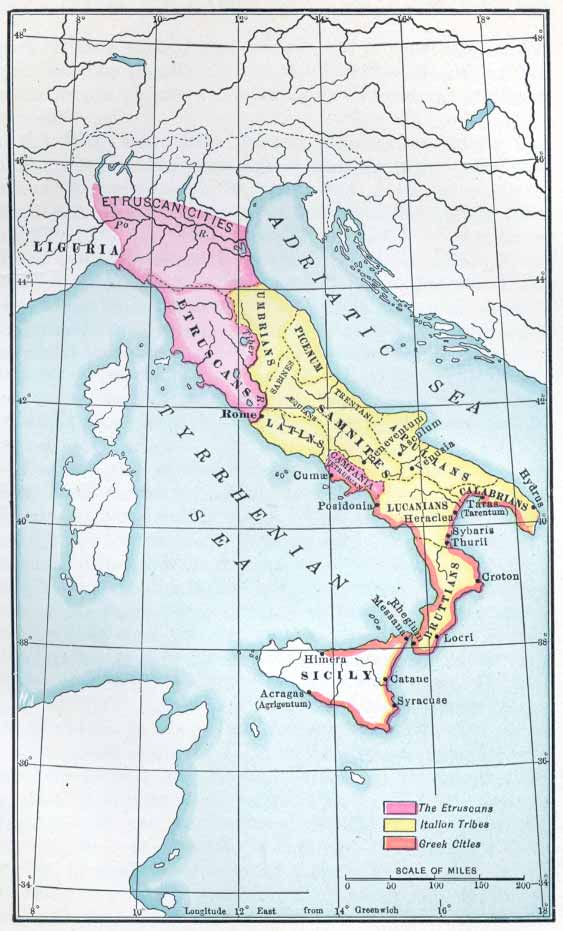Something something football something.
We’ve been talking about the rise of the Persian Empire for the past couple of weeks. This week, we’re going to shift gears a bit, and head west to Italy. Another power is beginning its rather slow rise from city state to world empire. This rise would prove much less meteoric than the rise of the Persians, but, perhaps, more enduring.
As usual, if you like this sort of content, feel free to comment below. Also, please check out the archive by clicking here.
The Reign of Lucius Tarquinius Superbus
Rome, traditionally founded in 753 BC, was one of many cities and towns founded by the Latin people. The Latins were one of many cultures in Italy at the time, and far from the most powerful. Trapped between the powerful Etruscan cities to the north, and the not quite as powerful, but still daunting, Samnites to the south and west. The Latins were not perfectly aligned- there tended to be tension between the smaller towns, and the increasingly dominant city of Rome.

In the early centuries, Rome was ruled by a monarch, who ruled with the assistance of the Senate, a body of the leading families of the city, known as the Patricians. The Senators represented their families, and the natives of Rome, to the kings, who weren’t always Roman. Dynastic politics in Rome tended to be rough sport, with a few families vying, often violently, for control of the city. Tarquin was no exception. His father, Lucius Tarquinius Priscus, had come to the throne on the back of an assassination, and he was deposed by assassination himself. That assassination was plotted by his wife, who then put Servius Tullius on the throne. Tullius hoped to avert strife, and so married his daughters to Priscus’ sons. Tarquin plotted with his sister in law, first to kill Tarquin’s brother and his wife, then to marry each other and kill Tullius as part of a coup to take the throne of Rome for himself.
Tarquin’s reign made several major breaks from previous reigns. His wife desecrated Servius’ body, which Tarquin refused to bury. He purged the Senate of his enemy, and refused to meet with Senators afterwards. Tarquin also purged his enemies from the Latin cities and towns, uniting the Latins and Romans to go to war against the Volscii. This war was successful, and brought in a great deal of wealth, which Tarquin used to fulfill a vow to build the Temple of Jupiter Optimus Maximus. He went to war with a Latin city that refused his leadership, sneaking his son in to take over the city. Once in charge, his son murdered the leading citizens, and gave the city over to Rome. He also built seats for the Circus Maximus, began digging the city’s sewer, and purchased the Sibylline Books at a steep cost.
The pace of building, and its cost, raised discontent in Rome amongst the populace, while his rejection of Senatorial guidance made him enemies amongst the leading families. In 509, Tarquin decided to go to war against the Rutuli, who had rather vast stores of wealth that Tarquin hoped to use to ease the burdens in Rome. He failed to take their capital, Adrea, and settled into a siege. While besieging the city, the leaders of the army grew bored, got drunk, and decided to have a bet to see whose wife was the most virtuous while they were away. They went back to Rome, and found that all their wives were partying, sleeping around and ingoring their children and household, except for Lucretia, the wife of Lucius Tarquinius Collantinus, a cousin of Tarquin’s. During the visit, Sextus Tarquinius, Tarquin’s son, decided he had to have Lucretia. A few days later, Sextus returned to Lucretia, and tried to seduce her. When that didn’t work, he raped her.
Afterwards, Lucretia called her father and told him what happened. Unable to live with the shame of being raped, she then killed herself. Collantinus, along with Lucretia’s father and his friends, Publius Valerius and Marcus Junius Brutus, swore to avenge Lucretia and throw the Tarquinians from the city. Brutus summoned the Senate, and accused Sextus of rape, and laid out the city’s many grievances against Tarquin. He asked the Senate to depose the King, which they did. Rather than choose a new king, they decided to split the powers of the king between two men, Brutus and Collantinus, naming them consuls and giving them power for a year. Sextus fled, only to be killed by the leaders of another city for his crimes.
Tarquin Strikes Back
Tarquin didn’t take the coup lying down. He called together his army, which was loyal to him, and contacted some allies he had in other cities, who brought troops. His first move, though, was to send an envoy back to Rome. The envoy’s ostensible purpose was to recover Tarquin’s wealth so he could head into exile. However, the envoy’s actual task was to foment a counter-coup. Brutus sniffed this effort out early, and it allowed him to purge the Senators still loyal to Tarquin. He then gathered an army, and headed out to fight Tarquin’s force. The two sides met in the Arsian Forest outside Rome. Brutus led a cavalry charge against a force led by Aruns Tarquinius, the second son of Tarquin. The two met at the heads of their forces, and, in a single pass, stabbed each other with spears and both fell, dead. However, Brutus’ forces carried the day, routing Tarquin’s Etruscan allies and putting the Royalist army to flight.
Tarquin, though, wasn’t really a give up sort of guy. He decided to head to Clusium, up the Tiber from Rome in Tuscany. This wealthy, powerful city was led by Lars Porsena, who agreed to help Tarquin regain his throne. Lars gathered up his army, and, in 508, marched on the city of Rome itself.
The Romans did not sit on their heels and wait, In 508, they had elected Publius Valerius Publicola, the man who broke word of the plot against the Republic and had led the army to victory at the Battle of the Arsian Forest, as consul, along with Titus Lucretius Triciptinus, another well known commander. These two leaders tried to rally the Roman people to another year of resistance to Tarquin, spreading out the loot from the previous battles, and issuing a number of tax breaks, particularly to the poorest citizens. This rallied the Romans to further fighting, who quickly formed up a new army.
The Siege of Rome
Porsena formed up his army on the Janinculum Hill, across the Tiber River from Rome. The Romans crossed the river, and formed up their army on the plain between the hill and the river- a rather dangerous position to be in, but, perhaps the Roman commanders hoped the precarious position would encourage their men to fight. Once the armies drew up on the plain by the Bridge of Sublicius, they basically went at each other.
The initial fighting went well for the Romans. Despite being outnumbered, the Roman right pushed forward, and drove back Porsena’s left. However, numbers quickly told, and the Roman center collapsed after the men saw the two consuls carried off the field, seriously wounded in the fighting. The bulk of the Roman army headed back for the city, across the Bridge of Sublicius. Lars’ men followed in close pursuit, and tried to take the bridge. If they succeeded, then they could swarm in the city, and take Rome by storm.
Three men stepped up to defend the bridge while the citizens of Rome destroyed it: Spurius Laritus, Titus Herminius Aqulinius, and One Eyed Publius Horatius. Those three men stood across the bridge, slaughtering the rushing Etruscans and driving them back, fighting to hold the bridge. As the Romans behind them ripped up planks, they fought on. Eventually, there was just enough room for the men to retreat. Spurious and Herminius retreated, but Horatius remained behind to cover their retreat and hold it until the last parts of the bridge came down. Once the bridge was demolished, Horatius jumped into the river in full armor, despite several wounds, including a severe one to his buttocks. Despite the weight and his injuries, he swam to shore where he was rescued by the Romans. Permanently disabled, he was granted a pension and other support by the Romans after the war.
With the bridge gone, Lars had to settle in for a protracted siege. He blockaded the city and the river, and raided the area around the town. In response, the Romans laid a trap for his men, using a group of cattle to tempt a raiding party into an ambush. As the siege wore on, a Roman youth, Gaius Mucius, volunteered to sneak into the enemy camp and kill Porsena. He managed to make it into the enemy king’s tent, but mistook Porsena’s secretary for Porsena, and killed the wrong man. Mucius convinced Porsena, though, that the Romans had plenty of men waiting to kill him, which, eventually, led Porsena to open negotiations. In the negotiations, the Romans refused to take Tarquin back, but did give Porsena some hostages to return Roman land under his control. Meanwhile, Porsena gave the Romans some supplies as part of the deal, packed up his army, and went home.
In 507, Porsena sent envoys, asking for the Romans to take Tarquin back. The Romans refused again, and told Porsena that they’d never take Tarquin back, so please stop asking. Porsena agreed, and kicked Tarquin out, returning the hostages he’d taken the year before home. Some of his soldiers, impressed with the new government going up in Rome, decided to head over to the city for themselves, and check it out.
The Roman Republic was saved, at least for now.
